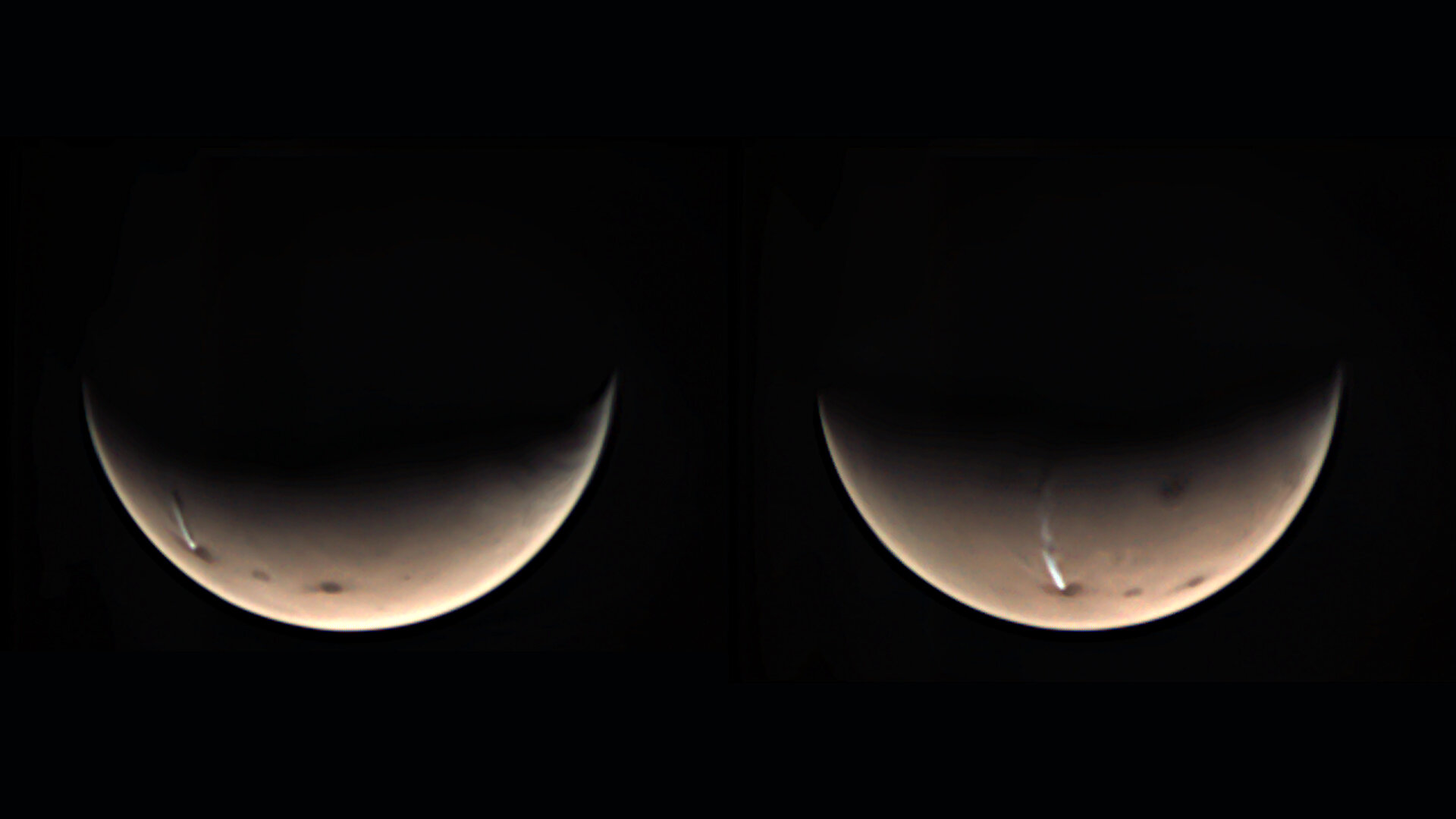A weird long cloud on Mars has returned. It's right on schedule, scientists say.
It's baaaaaaack …

A weird long cloud has formed so many times over the same Martian volcano that scientists have given up and named it.
Meet the Arsia Mons Elongated Cloud, or AMEC. Its long bright trail has become a familiar feature over the peak known as Arsia Mons, to the southeast of the more famous Olympus Mons. Although the cloud comes and goes over the volcano, scientists say it isn't formed by the volcano itself. And it is timely: Scientists affiliated with Europe's Mars Express orbiter were waiting for it to show up again on its yearly cycle.
"We have been investigating this intriguing phenomenon and were expecting to see such a cloud form around now," Jorge Hernandez-Bernal, a Ph.D. candidate at the University of the Basque Country in Spain and the lead author of the ongoing study, said in a statement released by the European Space Agency (ESA), which runs the spacecraft.
Photos: Red Planet views from Europe's Mars Express
"This elongated cloud forms every Martian year during this season around the southern solstice, and repeats for 80 days or even more," Hernandez-Bernal said. "However, we don't know yet if the clouds are always quite this impressive."
So far, scientists have caught the cloud clocking in as long as 1,100 miles (1,800 kilometers), according to ESA. The tail-like structure is made of water ice, and despite its location over Arsia Mons, it isn't formed by the volcano itself, scientists said, but instead by the way local winds interact with the topography.
And the Arsia Mons Elongated Cloud doesn't just come, stick around for a while, then dissipate. It forms and fades over the course of a few hours each local morning, then returns the next day. That makes the weird cloud difficult to study from orbit around the Red Planet.
Get the Space.com Newsletter
Breaking space news, the latest updates on rocket launches, skywatching events and more!
But Mars Express is uniquely qualified to do so. It carries an instrument called the Visual Monitoring Camera, which can photograph an unusually wide swath of the planet in a single frame. And the spacecraft's orbit lines up to put Arsia Mons in its view during the morning hours when the cloud is visible.

"The extent of this huge cloud can't be seen if your camera only has a narrow field of view, or if you're only observing in the afternoon," Eleni Ravanis, a graduate trainee on the Visual Monitoring Camera team, said in the statement. "Luckily for Mars Express, the highly elliptical orbit of the spacecraft, coupled with the wide field of view of the VMC instrument, lets us take pictures covering a wide area of the planet in the early morning. That means we can catch it!"
The scientists last spotted Arsia Mons' tail-like cloud in September and October 2018. At the time and again now, the days are the shortest of the year in the Red Planet's northern hemisphere and the longest of the year in the southern hemisphere. Arsia Mons itself is located just a bit south of the Martian equator and stretches to an altitude of about 12 miles (20 km).
Scientists hope that by continuing to study the strange cloud, they can begin to understand how long it has been making its appearances and why it appears only in the mornings.
Email Meghan Bartels at mbartels@space.com or follow her on Twitter @meghanbartels. Follow us on Twitter @Spacedotcom and on Facebook.
Join our Space Forums to keep talking space on the latest missions, night sky and more! And if you have a news tip, correction or comment, let us know at: community@space.com.

Meghan is a senior writer at Space.com and has more than five years' experience as a science journalist based in New York City. She joined Space.com in July 2018, with previous writing published in outlets including Newsweek and Audubon. Meghan earned an MA in science journalism from New York University and a BA in classics from Georgetown University, and in her free time she enjoys reading and visiting museums. Follow her on Twitter at @meghanbartels.
-
Bruzote No attempt to explain it in the article? Since upper air winds go west-to-east, maybe it's an orographic cloud produced by a N-S ridge? It seems like speculation must be happening, since local winds are happening. What that speculation is did not get mentioned in the article.Reply -
Mm70rj Reply
It is not bad if you consider that not long ago mankind believed that Mars was a dried and geologically dead planet... now we are studying active phenomena based on water... quite fantastic!Bruzote said:No attempt to explain it in the article? Since upper air winds go west-to-east, maybe it's an orographic cloud produced by a N-S ridge? It seems like speculation must be happening, since local winds are happening. What that speculation is did not get mentioned in the article.









